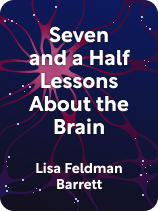

This article is an excerpt from the Shortform book guide to "Seven and a Half Lessons About the Brain" by Lisa Feldman Barrett. Shortform has the world's best summaries and analyses of books you should be reading.
Like this article? Sign up for a free trial here.
What is Seven and a Half Lessons About the Brain about? What are the main takeaways of the book?
In Seven and a Half Lessons About the Brain, Lisa Feldman Barrett sheds light on the inner workings of the brain. She provides exactly seven and a half lessons that detail how the brain works.
Read below for a brief overview of Barrett’s book.
Seven and a Half Lessons About the Brain by Lisa Feldman Barrett
In Seven and a Half Lessons About the Brain, Lisa Feldman Barrett playfully addresses some common mysteries that surround the human brain. Published in 2020, her explanations shed light on the inner workings of the brain and how they impact feelings, behaviors, and relationships. Barrett argues that by understanding the basics of how your brain works, you can take a more active role in deciding how to think and behave. Her seven-and-a-half lessons explore how the brain evolved, how it’s organized, how it develops throughout our lifetimes, and how it works on its own and with other brains.
Barrett is a leading neuroscientist, researcher, and science writer. She is a professor of psychology at Northeastern University and is the Chief Science Officer for the Center for Law, Brain & Behavior at Harvard Medical School. She has written more than 260 peer-reviewed articles as well as the popular book How Emotions Are Made (2017). Barrett is known for making neuroscience accessible to a lay audience through myth-busting explanations of what we know (and don’t yet know) about the brain and the mind (the brain being the physical organ, and the mind being our individual patterns of thought and action).
We explore Barrett’s seven-and-a-half lessons about the brain through four themes:
- How the brain is organized
- How the brain operates
- How the brain develops
- How brains collaborate
Part 1: How the Brain Is Organized
Barrett begins with an explanation of how the brain is organized: not as a layered structure with specific parts and jobs, as has long been thought, but as a network of neurons (brain cells that receive and transmit information) that can all perform different tasks according to need. By understanding the brain’s organization, we can recognize the flexibility and resilience of the human brain and learn what makes it different from the brains of other animals.
Part 2: How the Brain Operates
Turning from the brain’s organization to its functions, Barrett argues that the brain’s most important job isn’t thinking, it’s allostasis. Allostasis refers to the process of managing the body’s energy budget so it can survive and reproduce. All of its other functions (such as thinking) are secondary.
The Brain’s Most Important Function
While Barrett argues that the brain’s single most important job is managing the body’s energy budget, in The Body Keeps the Score, Bessel van der Kolk breaks down the brain’s primary role into several tasks, including:
- Signaling when your body needs essentials such as food, water, rest, shelter, safety, and sex
- Interpreting the world around you to point you in the right direction to find and satisfy those essential needs
- Creating the energy and initiating the actions to achieve those tasks
- Warning you of dangers and opportunities you may encounter as you pursue those tasks
- Adapting and responding to changing circumstances along the way
Part 3: How the Brain Develops
So far we’ve explored the brain’s hardware—its neurons, networks, and functions—but each individual’s brain develops differently, based on a combination of their genes and their environment. According to Barrett, brain development depends on the interaction between the genetic information already present in the brain and the environment it develops in, and this interaction has great implications for the healthy development of children’s brains.
Part 4: How Brains Collaborate
As we saw in Part 3, the brain requires input from our environment to properly develop. Long after it’s done developing, however, the brain continues to solicit information from other brains to perform daily tasks. This is what makes us social animals, and Barrett claims it has profound effects on our well-being.

———End of Preview———
Like what you just read? Read the rest of the world's best book summary and analysis of Lisa Feldman Barrett's "Seven and a Half Lessons About the Brain" at Shortform.
Here's what you'll find in our full Seven and a Half Lessons About the Brain summary:
- How the human brain develops and operates
- Why the brain isn't organized in the way you thought it was
- How brains collaborate with one another






